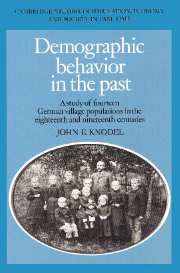 Demographic Behavior in the Past
Demographic Behavior in the Past Book contents
- Frontmatter
- Contents
- List of tables
- List of figures
- Acknowledgements
- PART I INTRODUCTION
- PART II MORTALITY
- 3 Infant and child mortality: levels, trends and seasonality
- 4 Infant and child mortality: socio-economic and demographic differentials
- 5 Maternal mortality
- PART III FAMILY FORMATION
- PART IV MARITAL REPRODUCTION
- PART V INTERRELATIONSHIPS IN DEMOGRAPHIC BEHAVIOR
- PART VI CONCLUSION
- Appendices
- Bibliography
- Index
4 - Infant and child mortality: socio-economic and demographic differentials
Published online by Cambridge University Press: 04 August 2010
- Frontmatter
- Contents
- List of tables
- List of figures
- Acknowledgements
- PART I INTRODUCTION
- PART II MORTALITY
- 3 Infant and child mortality: levels, trends and seasonality
- 4 Infant and child mortality: socio-economic and demographic differentials
- 5 Maternal mortality
- PART III FAMILY FORMATION
- PART IV MARITAL REPRODUCTION
- PART V INTERRELATIONSHIPS IN DEMOGRAPHIC BEHAVIOR
- PART VI CONCLUSION
- Appendices
- Bibliography
- Index
Summary
In the previous chapter, inter-village differences in mortality were examined and found to be substantial, especially along regional lines. Differences in mortality risks by age, both within the first year of life and within the childhood ages, and shifts in these differences over time were also analyzed. This chapter continues the examination of infant and child mortality by focusing on the differential risks associated with socio-economic status and demographic characteristics. Owing to the limited amount of information contained in the village genealogies, the examination of socio-economic differentials relates only to the occupation and village leadership status of the child's father. However, a far more extensive analysis of demographic differentials is possible because of the considerable information on demographic characteristics that results from the record linkage involved in the family reconstitution process. Analyses of demographic differentials in this chapter focus on infant and child mortality risks associated with the sex of the child, maternal age, birth order, sibship size, and birth interval.
A particularly interesting consideration in the study of infant and child mortality in the past is the possibility that child neglect or abusive child-care practices served as a way of limiting family size prior to the widespread use of contraception or abortion. While infanticide immediately following birth was not unknown in eighteenth- and nineteenth-century Europe, it was probably limited largely to desperate unwed mothers and was rare among married couples.
- Type
- Chapter
- Information
- Demographic Behavior in the PastA Study of Fourteen German Village Populations in the Eighteenth and Nineteenth Centuries, pp. 70 - 101Publisher: Cambridge University PressPrint publication year: 1988


